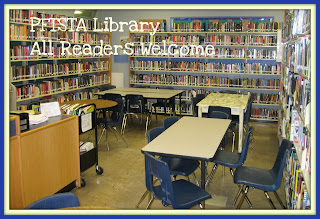100 Things Kids Would Miss without School Librarians
Okay, I try to stay on top of things, but somehow missed this list. Last May, as Nancy Everhart (at the time she was president of AASL) was finishing her Vision Tour of excellent school libraries around the country, she announced 100 things that students would miss if school librarians were eliminated from schools. As I read this list, I see so many of the activities that I do day in and day out in the library at Patrick Taylor Academy. I decided to post the list here so I will remember it, but also for others who might have missed this last year just like I did. Besides, we need to be reminded why we are so important to a school's culture.
100 Things Kids Will Miss If they don’t have a School Librarian in their School
Released by Dr. Nancy Everhart (everhart@fsu.edu) Past President, American Association of School Librarians (AASL) May 19, 2011
Books that are professionally selected to meet school and personal needs.
Equitable access to computers and other forms of technology.
Someone to talk to and someone who listens – the school librarian.
A place to get help when they need it.
A place to assemble with their friends openly.
Confidentiality.
Learning experiences that are enhanced through teacher/librarian collaboration.
How to evaluate information.
How to create information.
How to share information with others.
How to self-assess their work.
Project-based learning and the critical thinking skills it teaches them.
A place where the school culture is fostered and thrives.
A recommendation for a book that is suited to their interest.
A recommendation on what to read next.
Having stories read to them.
Respect for intellectual property.
A place to practice safe and ethical behaviors.
A librarian who doesn't judge a student because he/she takes out a book they enjoy reading.
A place to solve problems.
A place to use their imagination.
Book clubs.
Special programs and speakers.
Author visits.
Video chats with authors and experts.
Reading contests and prizes.
Instruction in how to use statewide databases.
Resources that align with the curriculum.
Acquiring 21st century skills.
Learning confidence.
Encouragement.
Book fairs.
A quiet place to learn.
One-on-one instruction.
A safe forum to explore new ideas.
The opportunity to borrow digital cameras, recorders, and laptops.
The ability to experiment with and master new technology.
Materials matched to their learning style.
Accepting learning as a life skill, not just an academic necessity.
The potential for higher standardized test scores.
Citing sources correctly.
Using information ethically.
Creating READ posters.
Creating book trailers.
Preparation for college.
Summer reading lists and programs.
Borrowing materials on interlibrary loan from public and college libraries.
Having resources available for school projects at the public library because the school librarian collaborated with them.
Cloud computing.
Learning to be a good digital citizen.
Poetry slams.
Battle of the books.
Digital literacy.
Time during homeroom, during lunch, during the school day, and after school to work on projects when they have no other access to computers.
Quality control.
A place to visit that is open, friendly, attractive, and a safe haven.
Additional resources for their classrooms.
In-depth exploration of a topic.
A knowledgeable, interested adult with whom to discuss books.
A library website that offers access 24–7 to an online catalog, selected electronic resources, databases, and curriculum-related websites.
Synthesizing information from diverse perspectives.
Writing a thesis statement or a critical question.
Reflecting on the information-seeking process.
Developing teamwork.
Responding to literature.
Using social media websites and tools (i.e., blogs, wikis, Facebook, Twitter, etc.) safely and responsibly.
Assistance and guidance in completing homework assignments Recommending books to their friends.
Help with history fair, science fair projects. A place to "shop" for free.
A place to practice decision-making skills.
The library, like the cafeteria and the gym, are places where all students (crossing grade levels and ability levels) mingle with one another.
Opportunities for meaningful student leadership A program that always differentiates to teach, support, and enrich.
A conduit for information to increase efficiency in the entire building.
Teachers who have had exposure to instructional support and collaboration.
Access to subscription databases, including time-saving instruction on which databases are appropriate for particular projects;
Technology expertise and instruction on software and web applications for writing, collaboration and presentation.
A connection between the outside world and the classroom.
The ability to construct and defend arguments E-readers.
Resources that will broaden their global perspective A smile of genuine pleasure for coming through the door.
Going beyond academic requirements.
Organizing personal knowledge.
Responding to literature.
Adapting to new situations.
Developing personal productivity.
Celebrating reading.
Celebrating learning.
A place to display their work both physically and virtually.
A place where the digital divide doesn’t exist.
A place to use their imaginations.
Learning the implications of a digital footprint.
Making recommendations for books that are followed.
Teachers who extend learning experiences beyond the classroom.
How to search efficiently and effectively.
Respect for copyright and intellectual property.
Helping other students.
A place to study without grades.




Wow! So amazing to see it as a list. When I was at secondary school the library was a cool balm amidst a rough and stormy sea. It's mad that so many are being closed. :( xxx Love xxx
ReplyDeleteI love the list too. I can't believe that it came out in May of 2011, and I missed it then. I figured others had also missed it. Judging by the numbers who have read this post, lots of people missed this.
ReplyDeleteIt's 2014 and your list is more than relevant. Thank you for helping all librarians.
ReplyDelete